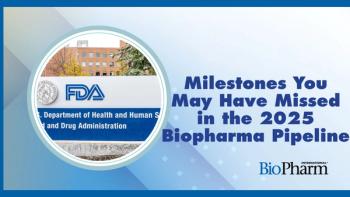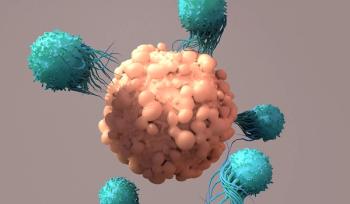
- BioPharm International June 2025
- Volume 38
- Issue 5
- Pages: 28–30
Therapeutic and Analytical Advancements Are Evolving Drug Substance Testing
Quality, stability, sustainability, and the increased and thoughtful integration of artificial intelligence are foremost in the minds of those on the leading edge of testing trends.
Drug substance testing is a critical component of the biopharmaceutical analysis process, carrying with it inherent benchmarks of safety and efficacy that must be met. In an exclusive interview with BioPharm International®, Joerg Ahlgrimm, CEO of SK pharmteco, summarizes the current trends in this field, and how ever-evolving regulations as well as technologies are moving companies forward toward greater accuracy and dependability for patients.
Regulatory considerations
BioPharm: Have there been notable recent regulatory changes in drug substance testing that have affected processes or quality issues? If not, are any expected in the coming year or so?
Ahlgrimm (SK pharmteco): I think we are seeing four key areas of focus—it’s probably not so much about change; it’s more about concentrating on those aspects. Clearly, data integrity is a significant topic, and all agencies worldwide continue to stress the importance of data integrity throughout the lifecycle of drug substance testing. Impurity characterization and control remains a significant topic of discussion. There is a trending focus on more thorough characterization of impurities, stricter controls, and an increased emphasis on understanding potential genotoxic impurities while establishing appropriate limits. Therefore, I believe this is a key focus area. Stability requirements are evolving and being continuously refined; there’s a progression in the expectations concerning that data, necessitating support for that data, as well as support for retest periods and shelf life. And then, a higher emphasis on process understanding and control strategies. There is a clear drive toward a deeper understanding of the manufacturing process and the establishment of robust control strategies. I believe none of this is revolutionary or sweeping; however, I feel that all of these areas are worth focusing on. When we look ahead, I believe we will clearly see advanced analytical technology on the horizon. Therefore, we can expect more emphasis on the use of advanced analytical technologies like mass spectrometry and spectroscopy for improved characterization and real-time monitoring. Regarding process understanding and control strategies, advanced methodologies will certainly increase focus in that area. We can anticipate a greater emphasis on sustainability and greener technologies overall, alongside a stronger focus on sustainable manufacturing practices—we have also started to implement our My Green Lab certification in this context—along with new approach methodologies, NAMs. In certain fields, particularly for safety testing, there is already a push to lessen reliance on animal testing. We have observed government agencies signing orders related to this and adopting new approaches. While this is more advanced in direct product testing, we may see a gradual effect on certain aspects of drug substance testing in the long term. We’ll see how this develops, but we all need to stay attentive to that progress. Finally, with the massive cuts currently occurring at FDA under the current administration, there is reason to be concerned regarding how FDA approaches its regulatory oversight of drug substance testing (and everything else for that matter). It would not be surprising to see FDA slow down and/or become more conservative over the next 12–18 months, as it adjusts to lower headcount and support within the agency. Innovators would be wise to interact with the agency as early as possible and stay abreast of ongoing regulatory trends as the field adjusts to the new normal.
Impact of new modalities on testing
BioPharm: Have newer modalities that have emerged in recent years caused a shift of any sort in analytical methods or procedures that were previously standard?
Ahlgrimm (SK pharmteco): We definitely see an increased emphasis on biological assays. Traditional methods often relied on physicochemical characterization, such as HPLC [high performance liquid chromatography] and spectroscopy. Newer modalities, including cell therapies, gene therapies, and complex biologics like ADCs [antibody-drug conjugates] or bispecific antibodies, necessitate a much greater focus on biological assays to assess potency, efficacy, and safety. And let’s be honest, for many of them, it’s even a question of how to best define potency and how to test efficacy on an ongoing basis? We also observe enhanced characterization techniques. The complexities of these new modalities demand more sophisticated analytical methods for comprehensive characterization. Additionally, there is an emphasis on impurity profiling specific to each modality. Consequently, newer modalities often differ significantly from those of small molecules. We now need to factor in aspects such as process-related impurities, vector-related impurities, and cellular impurities. Furthermore, we are witnessing the emergence of rapid in-process testing methodologies, which facilitate obtaining test results in real-time and potentially allow for process modifications based on those results. For some newer modalities—particularly cell and gene therapy—with short shelf lives or autologous nature, there’s a growing need for rapid testing methods that can provide quick turnaround for critical quality attributes. And the last thing I’d like to mention is increased regulatory scrutiny and comparability. That’s clearly an item that we have seen FDA pushing back on submissions in the past. When manufacturing processes for these complex modalities change, or when we have tech transfers, new plans, and so on, demonstrating comparability becomes increasingly critical. Rigorous analytical testing is essential to ensure product quality and patient safety, as nobody wants to repeat clinical studies for manufacturing changes. Therefore, comparability capabilities and evidence become more important.
Technological impact
BioPharm: What role is artificial intelligence (AI) playing? As those technologies and algorithms continue to evolve, will the use of AI increase even further?
Ahlgrimm (SK pharmteco): I firmly believe that AI, in the long run, will play an important role in revolutionizing the industry and lead to better outcomes at all levels, whether it’s yield, right-first-time, speed of tech transfer, the reduction of wet lab work necessary to develop a process, the number of tests ultimately needed to confirm quality, or overall productivity. These are just a few areas where I, or we as a company, believe that AI will significantly change our lives. We are currently in the early stages, like many others. The most important prerequisite for AI is digitalization, and we are still working in some areas to ensure that everything currently available on paper is converted into data so that AI can truly leverage it. I think the most important aspect of AI deployment is that people understand the benefits of the specific use case for each project. You should not pursue AI for its own sake, but there are already excellent use cases available that can enhance regulatory compliance, improve quality, and shorten development cycles, and we will see more of those in the future. AI has the potential to significantly accelerate process characterization by identifying complex patterns across large datasets that are often too nuanced for traditional statistical methods. For CGT, where variability is high and sample sizes are small, machine learning can optimize parameters like transfection efficiency, vector yield, or cell expansion conditions by correlating input variables with critical quality attributes. Ultimately, this allows developers to refine processes more efficiently and with greater confidence, reducing development timelines and improving product consistency. So yes, AI usage will continue to grow. It is in its infancy and will undoubtedly drive adaptation and revolution in the industry going forward.
Political implications
BioPharm: With respect to changes in tariff policies in the United States, are there hurdles between countries that must be worked out to ensure accurate and equitable testing?
Ahlgrimm (SK pharmteco): I don’t think there is necessarily an impact to the testing out of the tariff situation ... Right now, [we] always assume that shipping samples would be exempt from any tariffs. But again, as you said yourself, the situation is fluid, so you never know. But let’s assume that there’s no impact on testing and analytical execution, if you will. What there will be an impact on is, eventually, testing costs—meaning, if certain materials used for certain tests are coming from a specific region which now has a tariff, then of course tests may become more expensive. I’m not sure how big of a role this plays in a bigger picture. I think the impact of the tariffs to the raw materials for the manufacturing process itself is probably significantly bigger, and that’s clearly an area which we as a company watch. We are also looking into, what does it potentially do to our customers’ behaviors? And how much are they eventually altering their supply strategies? And how do we, as a service provider who already today has capabilities and capacities on the three main continents (being the US, Europe, and Asia), how do we continue to build up that network in order to meet the ever-changing requirements? So that’s clearly how we see it. The pace of those changes is exacerbating the complexity of policy implementation and mitigating actions, and we clearly see some long-term impacts. We see increased cost for materials and APIs. We see potential delays and disruptions in production. We see potential staffing constraints as manufacturing moves into regions which haven’t had so much manufacturing recently. We’ll definitely see a shift toward domestic or regional manufacturing. Pricing pressure from the customers, potential retaliation from other countries ... I mean, I think the impacts are manifold, and as a company, we’ll watch them, and we’ll do what we can, within limits of course, in order to ensure that we mitigate those issues.
On the horizon
BioPharm: What else do you see potentially impacting drug substance testing in the future?
Ahlgrimm (SK pharmteco): I think what’s very important right now from my point of view is that we have seen, over the past year, significant changes in the dynamic of the advanced therapy market. And the outcome of many of those changes right now, from what we can see, is that companies have focused on the scientifically more promising assets. We also have seen significant advancements in, for example, analytical capabilities, the ability to find a potency metric which is approvable by the authorities. Many of those advancements make us positive, in a sense, that we will see more clinical success rates going forward for the advanced therapies. And overall, while we have less assets in active development globally, we most likely see more of them being successful in getting licensed and becoming commercially successful, because companies were forced to go through a very rigorous process to assess their portfolios for future marketability and for scientific advancements. And I think that has happened, continues to happen to some extent, and we will see this lead into the next wave of advanced therapies on the rise.
About the author
Patrick Lavery is an Editor for BioPharm International®.
Article details
BioPharm International®
Vol. 38, No. 5
June 2025
Pages: 28–30
Citation
When referring to this article, please cite it as Lavery, P. Therapeutic and Analytical Advancements Are Evolving Drug Substance Testing. BioPharm International 2025 38 (5).
Articles in this issue
6 months ago
Qualifying Expertise for Quality Support6 months ago
Guidance on Quality Culture Standards6 months ago
Inspiring DevelopmentsNewsletter
Stay at the forefront of biopharmaceutical innovation—subscribe to BioPharm International for expert insights on drug development, manufacturing, compliance, and more.





